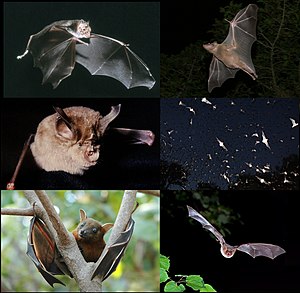**Taxonomy and Evolution**:
– Bats belong to the order Chiroptera and are the only mammals capable of sustained flight.
– There are over 1,400 bat species worldwide.
– Flight in bats evolved once according to genetic studies.
– Genetic evidence supports the division of bats into Yinpterochiroptera and Yangochiroptera.
– Bats were formerly grouped with treeshrews and primates.
**Anatomy and Physiology**:
– Bats have unique adaptations for flight, including flexible finger bones and wing morphology.
– Megabats and microbats have distinct anatomical features related to their diet and behavior.
– Bats have specialized dentition for their feeding habits, such as insectivory or nectar-feeding.
– The wing membranes of bats have touch-sensitive receptors for flight efficiency.
– Bats have evolved specialized internal systems for efficient circulation, respiration, gas exchange, and digestion.
**Behavior and Diet**:
– Bats exhibit diverse feeding behaviors, with megabats primarily consuming fruit, nectar, or pollen, and microbats feeding on insects.
– Different bat species have varying mating behaviors, gestation periods, and reproductive adaptations.
– Roosting habits, flight patterns, and foraging strategies vary among bat species.
– Megabats and microbats have differences in sensory adaptations, such as echolocation and vision.
– Bats play crucial ecological roles in pollination, seed dispersal, and insect control.
**Ecology and Habitat**:
– Bats are widely distributed mammals found in almost every habitat on Earth, except the Arctic, Antarctic, and a few isolated islands.
– Tropical areas have higher bat species diversity compared to temperate regions.
– Bats select roosts in various natural and human-made structures, exhibiting different roosting behaviors.
– Bats’ size, weight, and wingspan influence their hunting abilities, prey selection, and ecological roles.
– Bats contribute significantly to ecosystem functions through seed dispersal, pollination, and insect control.
**Adaptations and Sensory Systems**:
– Bats have evolved specialized adaptations for flight, including wing morphology, skeletal structure, and muscle development.
– Sensory systems in bats, such as echolocation, vision, and magnetoreception, play crucial roles in navigation, foraging, and communication.
– Bats exhibit thermoregulation mechanisms, torpor behavior, and energy conservation strategies to cope with environmental challenges.
– Bats have diverse diets, including insects, nectar, fruit, and vertebrates, with specific adaptations for feeding on different food sources.
– Size variations in bat species influence their hunting strategies, prey preferences, and ecological interactions.
Bats are flying mammals of the order Chiroptera (/kaɪˈrɒptərə/). With their forelimbs adapted as wings, they are the only mammals capable of true and sustained flight. Bats are more agile in flight than most birds, flying with their very long spread-out digits covered with a thin membrane or patagium. The smallest bat, and arguably the smallest extant mammal, is Kitti's hog-nosed bat, which is 29–34 millimetres (1+1⁄8–1+3⁄8 inches) in length, 150 mm (6 in) across the wings and 2–2.6 g (1⁄16–3⁄32 oz) in mass. The largest bats are the flying foxes, with the giant golden-crowned flying fox (Acerodon jubatus) reaching a weight of 1.6 kg (3+1⁄2 lb) and having a wingspan of 1.7 m (5 ft 7 in).
| Bat Temporal range:
| |
|---|---|
 | |
| Scientific classification | |
| Domain: | Eukaryota |
| Kingdom: | Animalia |
| Phylum: | Chordata |
| Class: | Mammalia |
| Clade: | Scrotifera |
| Clade: | Apo-Chiroptera |
| Order: | Chiroptera Blumenbach, 1779 |
| Suborders | |
|
(traditional): (present): | |

| |
| Worldwide distribution of bat species | |
The second largest order of mammals after rodents, bats comprise about 20% of all classified mammal species worldwide, with over 1,400 species. These were traditionally divided into two suborders: the largely fruit-eating megabats, and the echolocating microbats. But more recent evidence has supported dividing the order into Yinpterochiroptera and Yangochiroptera, with megabats as members of the former along with several species of microbats. Many bats are insectivores, and most of the rest are frugivores (fruit-eaters) or nectarivores (nectar-eaters). A few species feed on animals other than insects; for example, the vampire bats feed on blood. Most bats are nocturnal, and many roost in caves or other refuges; it is uncertain whether bats have these behaviours to escape predators. Bats are present throughout the world, with the exception of extremely cold regions. They are important in their ecosystems for pollinating flowers and dispersing seeds; many tropical plants depend entirely on bats for these services.
Bats provide humans with some direct benefits, at the cost of some disadvantages. Bat dung has been mined as guano from caves and used as fertiliser. Bats consume insect pests, reducing the need for pesticides and other insect management measures. They are sometimes numerous enough and close enough to human settlements to serve as tourist attractions, and they are used as food across Asia and the Pacific Rim. However, fruit bats are frequently considered pests by fruit growers. Due to their physiology, bats are one type of animal that acts as a natural reservoir of many pathogens, such as rabies; and since they are highly mobile, social, and long-lived, they can readily spread disease among themselves. If humans interact with bats, these traits become potentially dangerous to humans. Some bats are also predators of mosquitoes, suppressing the transmission of mosquito-borne diseases.
Depending on the culture, bats may be symbolically associated with positive traits, such as protection from certain diseases or risks, rebirth, or long life, but in the West, bats are popularly associated with darkness, malevolence, witchcraft, vampires, and death.
